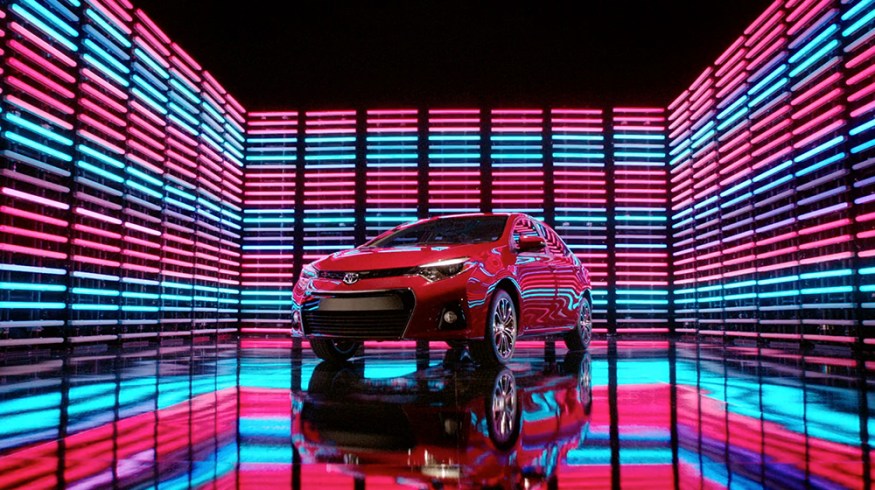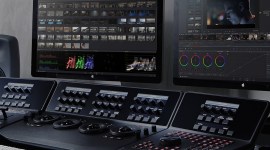
Insights from Pro Colorist Rob Bessette
What does it take to break into the big leagues? Are there advantages to working freelance versus taking a job at a big color house? Gain real-world insight from professional colorist Rob Bessette.
Rob Bessette is a senior colorist working at the Boston post house Finish Post. Bessette has worked with a range of commercial clients, including Coca-Cola, Toyota, Chili’s, and recently, a promo for Epix’s “Road to the NHL.”
Watch Bessette’s color montage:
Talk about how you became a colorist.
Out of college I landed an internship and learned how to handle film, patch decks, and use Smoke and Flame. I eventually got hired as a nighttime assistant where I did all the tape dubbing, archiving and prep for the next day. I did that for about a year. One day they needed an assistant in the color suite. Everything used to be linear, so assistants would need to change all of the film reels, make sure all the selects were colored and then lay everything off to tape at the end.
I did double-duty with both jobs. I sat with the colorist with 20 years experience under his belt and apprenticed with him, learned what he was doing and how he worked with clients. I started prepping his projects and working with 35mm footage, which sometimes for coloring just getting good footage to work with is half the battle. It’s hard to make bad footage look good, especially when you’re talking about footage acquired with DSLRs and mini DV and stuff like that.
After a year of doing both jobs, I was getting burned out and told my bosses I wanted to graduate to color and came on to assist color full-time. Eventually I got some requests from clients and after a few years the colorist I apprenticed with went somewhere else and I got a shot at getting some work with paying clients. That was about 10 years ago now.

What’s your color grading software of choice? Any specific reason for that platform?
I’ve been on DaVinci before it became Resolve. I learned on the Davinci 2k Plus back in 2004 or 2005. Those were the days of 16 and 35mm transfers and digibeta tape. Since I learned on Davinci, Resolve was an easy transition. Back in the day I also tinkered with Apple Color, Quantel and Avid Symphony. I’ve never toyed with Baselight or Nucoda which are next on my list.
What Resolve features have been game-changers for you? Any secret tricks that’ve changed your workflow?
As I’ve gotten more experience, getting into those mid-high relationships and mid-low relationships in the Log tab are really big for me. I’ve also really enjoyed working with the Hue vs. Saturation curves. The tracking is obviously huge. When I saw Resolve for the first time and saw the tracker, I knew we had to get it. That was a no-brainer.
Yeah, I mean it pretty much goes real time, or even faster.
Faster than real time! The ease of the node-based workflow or even feeling your way around the panel just feels really natural and smooth. There’s no clunkiness. It does whatever I want it to do. The great thing with Blackmagic is that they listen to the feedback. I emailed them a while back and asked if there was a feature of turning a circular power window into a custom bezier window. One release later, that was in there. Clearly I wasn’t the only one who requested it. They have all these big movies being made on the software. I have trouble wrapping my head around the fact that they give it away for free.

When Blackmagic Design released its Davinci Resolve software for free, there was an explosion of new colorists on the scene. The big color houses felt the pinch of the 2008 recession and started taking every job possible. Do you find it difficult to find work in this climate with these factors?
Budgets definitely run the gamut. We see a lot of high-end broadcast work, but there’s a lot of web content too. People are pushing a lot of social media work now. Instagram is blowing up with video content and advertising. Whereas Instagram used to contain more user-sourced content, there’s a lot more commercial content on there now.
Right – Instagram users can now upload up to 60 seconds of video, up from 15 seconds, which enables advertising companies to tell more engaging stories.
Yeah. That said, budgets are shrinking across the board. Some ad agencies keep work in house to save money on smaller jobs, but they’ll work with us when they need more professional work. We definitely feel a little bit of the budget pinch, but a lot of people are still putting out great work.

Is there ever a point where you don’t take the job on? Color jobs tend to run for a couple of hours to a day, so I wondered if any job is too small or if you always try to accommodate.
There’s definitely jobs that I’ve personally turned down, but if I do, I offer them to a junior guy. But in general, we try to work with the ad agencies. We have an hourly rate and a day rate that they know going in, but sometimes they have a budget cap in mind, and as long as it’s within a decent range, we tend to play ball. It gets hairy when someone has a 90-minute feature. We end up extending the timeline to a month or five weeks to work on it during our downtime so we can still prioritize full-rate work. As long as the filmmaker understands that, we’ll work with them to make it happen.
It’s the old good/fast/cheap paradigm — pick two. You’re obviously good, so if it’s cheap it can’t be fast. In editorial, low-budget music videos are a several-week commitment. Coloring that same music video might only take half a day, so it’s easier to fit in, and it can be great for exposure and creativity. A feature can really suck up the time and resources.
If we’re working on a commercial, there’s typically a bigger budget, because it’s actually selling something. There’s money to be had at the back end. A music video or a movie, maybe it’ll make money, maybe it won’t. Indie movies are a toss-up. Our bread and butter is generally commercials, but we don’t tend to turn down work.
Are you finding there’s a lot of competition in Boston?
The Boston color world is very small. Most of our competition on the East Coast is in New York City. The big color houses also have remote connections where agencies can sit in Boston and remotely supervise the session in New York.
Being based in New York, I’ve seen the upsurge of freelance colorists emerging, even though there are only a handful of big companies. It’s been interesting to see those freelancers taking work from the bigger houses.
Finish Post is in a middle ground. It still has a boutique vibe. Freelancers make their money on being cheaper than a facility. I take only a fraction of my rate, but what I gain is infrastructure. I have an assistant and a producer, client services and the latest and greatest equipment. I know some freelancers that go from facility to facility and bounce around with whatever’s thrown at them. What colorists do is the same no matter what program we’re on.

What’s the most difficult part of dealing with clients? It’s difficult for many clients to articulate their color feedback.
I’ve gotten all sorts of adjectives to describe color from clients: dirty, funky, murky, sweet, romantic. I get all these weird words that I’m supposed to interpret as meaning warmer or cooler or more green or whatever. I have to associate those words with doing something with the highlights or shadows, or maybe I need less contrast or saturation to get that look. Being able to think about what those adjectives mean is really the driving force. I always ask for references, whether it’s a menu for a cheeseburger or if it’s a source of inspiration. Those go a long way to hone down a look you’re going for. Managing client expectations is a whole other aspect of the job that’s really one of the untold arts – being able to get them what they want without them exactly knowing what they want.
Do you run into clients saying that images look different on other monitors still? Nowadays I’ve played cuts back full screen on the computer monitor to make sure clients are happy with it there. It makes them feel better about approvals. I’m not a stickler about the single calibrated monitor any more.
The days of saying ‘I’m right and you’re wrong’ in the color suite are gone. You can offer up your opinion and you can listen to theirs and explore, but no client wants to hear ‘you’re not right.’ If there’s a reason to have a collaboration, you talk it out and see what various things look like, to try what people said. If you tried something that doesn’t work, the client sees they weren’t right anyway. Sometimes something they suggested does work! You didn’t expect it but you got a better product in the long run.
As far as monitoring goes, that’s the bane of my existence. ‘I looked at the cut on the phone on the train while it was rainy out, and it looked weird.’ It’s going to happen pretty much no matter what you do. In an electronics store with 50 TVs in front of you, every single one looks different. How do you compensate for that? You can’t. I’ve walked the slippery slope of making various versions, and it just gets you into trouble, because everyone sees things a little differently. It’s probably the most common conversation that I have in the suite, and it’s one that I don’t necessarily enjoy having.
There’s an app called Shady on the Mac that can artificially darken the computer screen. I sometimes use this while in session with clients who get hung up on different displays. No one thinks a darker monitor looks better, so instinctively they look at the brighter one.
Regarding “right” or “wrong” in a color context, it would be even worse to point to the scopes and say that you’ve scientifically matched the shots, that it’s correct because the equipment says so. When you cut from a wide to a close-up, the client might perceive a person as being more saturated just because they’re closer to the camera. At a certain point, you have to be willing to abandon the scopes in favor of the client’s eyes.
You can’t tell someone they’re wrong because the equipment says so. From their perspective, they’re saying they’re right because their eyes are telling them so. That’s what it looks like to them. They don’t care what the machine says. I see it all the time with wides and close-ups with 4k footage. For projects delivering in HD you can blow up the footage quite a bit, but even with the same exact dailies cut together, shots feel different when you zoom.
It’s pretty crazy how the eyes work like that. Let’s say you’re coloring a :30 with a :15 cutdown. Shots are perceived differently because of the shots that come before or after it.
It all depends on context. One of our biggest jobs is to make sure that everything’s consistent. It’s not the most glamorous part of the job by any means, but if your work is consistent and the common person doesn’t notice your work, you’ve done a good job.
It’s one of those invisible art forms, like editing. Most of the work is done in making the job consistent. When it’s time to impose a look on the job, that’s really where the client comes in. Is that similar to your process?
That’s kind of how I work as well. When I start, I take an initial look at the footage so I know what to expect, what might work and what might not. Then I offer up some ideas and explain why. I’m not throwing looks at them just to throw looks at them. When we arrive at a style, they kind of let me do my thing. When I get about 80% of the way there, then we sit down for the fine-tuning. So my client involvement is very involved in the beginning in coming up with a look and the direction, then I do most of the work in the middle, and at the end everyone comes together to put the final polish on it.

What’s the dynamic in working with DPs? Cinematographers often speak in very technical terms as opposed to more emotional terms of what the shots are doing for them. Does this ever get in the way?
I’ve had that happen a couple of times. The first few times I was a little annoyed by it, but I’ve learned to roll with it now. They’re not trying to do the work for me, that’s just how they talk. If we can get on the same page, ultimately that leads to a better image and everyone’s happy, and that’s what it’s all about. I could see how it could get taken the wrong way, but with clients you just have to be able to roll with the punches. You can’t let anyone push you around, and you have to stand up for your vision, but you have to also be willing to hear other ideas as well. The worst thing you can do is run forward stubborn and bullheaded with an ‘I’m right, you’re wrong’ attitude. No one wants to work with that guy.
Any advice for people just starting out in color correction?
Get as much real-world experience as you can. One thing that everybody has now that they didn’t have before was accessibility to the software. When I started out it was this kind of black art nobody knew about. The only people who had access to it were people who worked at big post houses or film processing labs. Now, I have it on my laptop that I can carry around.
What differentiates you now is how you handle yourself and your creative looks and styles, being able to come up with ideas on the spot and using the software really as an extension of your mind. You shouldn’t be looking around the software for where each button is. You should be able to instantly think with instinctual reactions, and that really comes with practice and muscle memory and learning how footage reacts to certain environments. The only way to do that is with practice, and as much as you might begin by practicing on footage downloaded from tutorial sites, there’s nothing like a real job where pressure is on you to learn it right.

Stay tuned for our continuing conversation series with colorists or read past interviews with Patrick Inhofer and Alexis van Hurkman.





